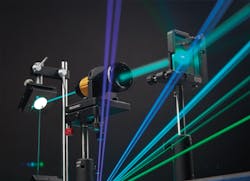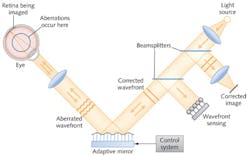OPTICAL COMPONENTS & SYSTEMS: Simplify laser system design with dichroic filters and mirrors
Dichroic laser mirrors and filters can improve reflectivity and power, and extend the lifetime and usability of these components in new applications. Designers can combine them to create simpler, more efficient systems that contain fewer parts to maintain, replace, and stock.
The first metal-coated mirrors were used in ancient Rome and the Middle East around the first century A.D., beginning a long history of using metals such as silver, gold, aluminum, and copper to produce general-purpose broadband high reflectors. However, these metallic coatings have significant limitations, among them:
• High susceptibility to laser-induced damage. Typical damage threshold of metal coatings range from 200 to 500 mJ/cm2 (with a 10 ns pulse), far lower than typical laser systems.
• Poor durability, with high susceptibility to abrasion, scratching, tarnishing, etc.
• Poor adhesion—the coating tends to separate from the glass over time especially when subject to changes in thermal cycling, humidity, etc.
Broadband laser mirrors
Modern sputtering techniques, such as ion beam and magnetron sputtering, produce dense dielectric films that provide superior reflectivity, enhanced mechanical properties, environmental insensitivity, and much higher laser damage thresholds. These broadband laser mirrors and laser beam combiners made with sputtered coatings have much longer lifetimes than metal mirrors, even during humidity and thermal cycling, and handling will not affect them as much. The coatings are hard enough that users cannot scratch them with normal cleaning and maintenance.
Designers can use dielectric mirrors in laser systems to increase reflections and create systems that have better resolution (see Fig. 1). Older systems typically had a variety of inexpensive metal-coated mirrors that provided reflections of 85–95%. State-of-the-art broadband laser mirrors offer reflection in the 98–99% range, delivering more photons to the sample. Using mirrors with higher reflectivity creates devices with better overall resolution, accuracy, and repeatability. Also, they can decrease the amount of laser light required, allowing designers to make more efficient use of the available power, which, in some biomedical applications, could mean the difference between life and death of a cell.
While metal mirrors typically have very broad ranges (silver, for instance, reflects from 500 nm through the longwave infrared wavelength of >10 μm), broadband dielectric mirrors have limited ranges. Typically, they either serve the full visible spectrum, a range of the near-infrared (NIR) spectrum (from 700–1100 nm), or, in the largest case, near-ultraviolet (NUV) through NIR (350–1100 nm).
Outside of their designed range, the mirrors may become highly transmissive, and the extent of that transmissivity can vary from lot to lot. Consequently, if the spectral range of the instrumentation is outside of the spectral range of the dielectric mirror, the designer has to understand how that may affect the system.
Designers must also be cautious of how sensitive the system may be to polarization. Dielectrics are more polarization sensitive than metal coatings, so mirrors are usually used at 0° or 45° to avoid performance degradation when working at odd angles. To get around this sensitivity, custom dielectric coatings are easy to design so the mirrors can be used at different angles.
The cost for precision metal or dielectric mirrors is of the same order of magnitude for volume quantities of small mirrors typically less than 1 in. But the larger mirrors with diameters on the order of meters are more expensive per coated area. Long-term cost of ownership of small dielectric mirrors may be substantially less than metal mirrors, depending upon the lifetime and environmental conditions of the instrument in which they are being used.
Manufacturing techniques
Laser dichroic filters, sometimes called dichroic plate beamsplitters or dichroic mirrors, split incident light based on wavelength. They are coated with thin films to achieve a desired transmission and reflection percentage across a given spectrum. Often used as both additive and subtractive color filters, the color varies with angle of incidence and thickness of deposition material.
Dichroic coatings on mirrors or filters transmit or reflect light depending on wavelength rather than polarization. They offer sharp control switching between reflection and transmission, making them critical components in many laser applications. Metallic coatings tend to be more spectrally flat.
Thin-film dichroic coatings can be sputtered or thermally evaporated; evaporation coating techniques, which use heat to disperse materials onto the glass, provide relatively soft coating layers with low bonding adhesion to the glass below. Filters used in laser applications are subject to thermal changes of the lasers as they emit heat during on and off cycling. Exposing filters with thermally evaporated coatings to these changing thermal environments over time will degrade the bonds between the glass, affect the filter's performance, and require replacement sometimes several times per year.
While there is not a large cost difference between the two methods, sputter-coated dichroic filters have hard layers of coating materials that become part of the glass, making them temperature and humidity insensitive. The coatings last the lifetime of the filter, providing cost, performance, and labor advantages and the same other advantages mentioned previously for sputter-coated mirrors.
New laser applications
Many applications using multiple laser sources are now able to use filters that may never have previously contained them. The advances in coating technology allow customers to design devices that easily incorporate multiple laser channels, simultaneously creating instrumentation with improved acuity and utility. In the past, practical limitations of coating technology forced designers to take a mix-and-match approach, creating bulky or single-purpose devices.
Now, with improved optics, multiple lasers can perform simultaneous checks and source them on the fly. They can search with multiple spectra, observing red fluorescence before green, then blue, all using the same single component. They make it possible to design an automated system, with significantly higher throughput. Systems are made simpler by having fewer components, so the need to handle and manipulate signals and components is gone.
Many diagnostic systems containing multiple lasers can benefit from using broadband or multispectral filters and mirrors, including flow cytometry in the biomedical industry, and many microscopy techniques such as atomic force microscopy, total internal reflection fluorescence microscopy, super-resolution microscopy, and optical coherence tomography.
For example, in a generic in vivo flow cytometry system, a dichroic filter could be critical in detecting cells that have been tagged with fluorescent dyes that bond to white blood cell antibodies. The combination of the dichroic filter and the broadband mirror makes it possible for this setup to both monitor the number of white blood cells in circulation (to analyze the progression of disease/infection, or to assess the efficacy of treatment) and to visualize the results through the use of confocal microscopy. The high reflection of the mirror, coupled with the sharp transition between transmission and reflection of the dichroic, provides images with improved signal-to-noise ratio, while simultaneously improving the count of the circulating cells (see Fig. 2).In addition, applications with yttrium aluminum garnet (YAG) lasers can benefit from using broadband dielectric mirror technology instead of metal-coated mirrors. Typically, a 532 nm YAG laser would use a dielectric-coated mirror that reflects near perfectly at 532 nm. But if the device has to switch between 405, 532, and 1064 nm, the system would require separate mirrors for each, making inventory management and assembly more complicated.
Broadband dielectric mirrors can replace a dozen mirrors and make the logistics behind designing, building, and stocking a system easier. Dielectric mirrors can be designed to reflect 99% at 532 nm but transmit at 1064 nm, or have high reflection at both wavelengths. The same mirror can be used in both channels and provide high efficiency in a broad range.
Designers are able to get the three most common fundamentals of the neodymium-doped (Nd:YAG) lasers and everything between with a single mirror. As a result, they are no longer constrained to the inefficiencies of metal coatings, or the simplicity of simple quarter- and half-wave dielectric stacks. Coating technology encourages system differentiation through complex coating designs that ultimately simplify and improve the end-user experience.
About the Author
Gregg Fales
Senior Product Line Manager, Edmund Optics
Gregg Fales is senior product line manager, both at Edmund Optics (Barrington, NJ).

